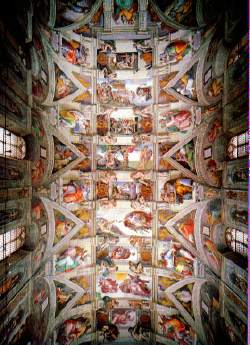|
|
|

The Sistine Chapel was built between 1475 and 1483, in the time of Pope Sixtus IV della Rovere. Its basic feature is the papal function, as the pope's chapel and the location of the elections of new popes. It was consecrated and dedicated to the Assumption of the Virgin on 15th August 1483. The chapel has no architectural distinction, it is rectangular in shape and measures 40,93 meters long by 13,41 meters wide, i.e. the exact dimensions of the Temple of Solomon, as given in the Old Testament. It is 20,70 meters high and is roofed by a flattened barrel vault, with six tall windows cut into the long sides, forming a series of pendentives between them. The architectural plans were made byBaccio Pontelli and the construction was supervised by Giovannino de'Dolci. Later alterations modified the original exterior. Michelangelo was commissioned by Pope Julius II della Rovere in 1508 to repaint the ceiling; thework was completed between 1508 and 1512. He painted the Last Judgement over the altar, between 1535 and 1541, being commissioned by Pope Paul III Farnese. For great ceremonial occasions the lowest portions of the side walls were covered with a series of tapestries depicting events from the Gospels and the Acts of the Apostles. These were designed by Raphael and woven in 1515-19 at Brussels. The building in some respects can be considered a personal monument to the Della Rovere family, since Sixtus IV saw to its actual construction and the frescoes beneath the vaults, and his nephew Julius II commissioned the ceiling decoration. Oak leaves and acorns abound, heraldic symbols of the family whose name means literally "from the oak." The decoration of the chapel was cleaned and restored in recent decades. The project started with the fifteenth century frescoes in 1965. The restoration of the lunettes, the vault and the Last Judgment started in 1980 and was terminated in 1994. The restoration produced a spectacular result.

Michelangelo returned to Rome in 1508. He was to paint the Twelve Apostles and a few ornaments on the ceiling of the Sistine Chapel. He, who had always insisted that he was a sculptor, was thus to learn the art of fresco painting, and practice it on a vault decorated by fifteenth-century artists as a starry sky. However, as he began work on the project, Michelangelo conceived grander designs for the decoration of the ceiling. He spent the time between then and the 31st of October 1512 painting more than 300 figures on the ceiling of the Sistine Chapel. The ceiling of the Sistine Chapel is a shallow barrel vault, about 40 m long by 13 m wide, with windows in both long sides which cut into the vault so as to produce a series of pendentives between the windows, which are surrounded by lunettes, and have triangular shaped areas, called spandrels, above them at the junction of wall and ceiling. The central part of the vault is almost flat, and it was probably because of this that Michelangelo defined the centre by means of a painted cornice which appears to be cut by five pairs of painted ribs running from side to side. The spaces so obtained form five small and four large rectangles, and these were filled with scenes from the Old Testament. The choice of subject was conditioned by the existence of the two series of frescoes painted in 1481-82 on the lower part of the walls; these consist of scenes from the life of Moses and the life of Christ, treated as parallels from the Old law and the New. The obvious choice, therefore, was of scenes from the history of the world before the Mosaic Dispensation, beginning with the Creation. The sequence of the frescoes runs from the altar to the entrance wall, whereas the order in which they were painted is the reverse, so that the most important scene, from the standpoint of iconography - the Primal Act of Creation, which occupies the small rectangle immediately above the altar - was almost the last to be painted. At the opposite end, over the entrance used by the laity, the first small rectangle to be painted contains the Drunkenness of Noah, symbolic of man in his lost state wholly unconcious of God, and the Biblical order of the narrative is slightlyadjusted, partly to enable the complex scene of the Deluge to occupy a large rectangle, and also to obtain a progressive ascent, spiritually, from the pit of man's degradation to the ultimate splendour of God. There is also a break in the narrateH╩╚corresponding to the original division of the chapel by the screen and the pattern of the floor mosaic into two equal parts - a nave for the laity and a presbitery for the clergy - but resiting of the screen in later years to make the nave smaller and the presbitery much larger has destroyed the significance of this division.
(Above text from The Web Gallery of Art by Emil Kren and Daniel Marx.)